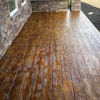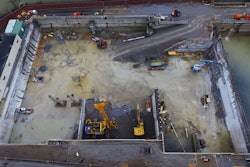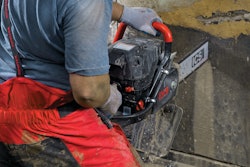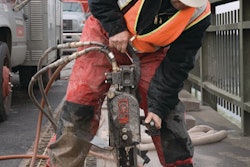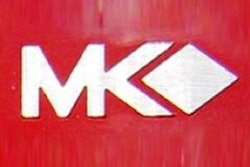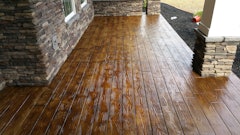Short-distance concrete cuts can take many forms on a jobsite, whether it be cutting concrete pipe to size; creating openings in concrete walls; cutting patches for road work; or producing utility cuts in concrete slabs. Likewise, the equipment used to produce these cuts varies in both form and capabilities.
The most common concrete saws for hand work or short-distance flat sawing applications include gas and electric cutoff saws (also known as disc or quick-cut saws), ring saws and concrete chainsaws, states Kent Johnston, regional sales, ICS Education & Market Development. "The most common disc saws are 12- and 14-in. blade diameter," he notes. "There are hand saws available to 20 in., but they are quite expensive and usually hydraulic powered."
A 12- or 14-in. saw is limited to a cut depth of 3 1/2 to 4 5/8 in., Johnston points out, whereas a 20-in. saw can cut to about 8 in. "Ring saws can cut to a depth of 10 in., but are limited to 6 in. without overcutting the corners," he indicates. Gas-powered concrete chainsaws, on the other hand, can cut as deep as 16 in. without overcutting.
Such hand-held saws are popular due to their versatility. Take Husqvarna's power cutters, for example. "Hand-held power cutters can be used for a variety of different applications," says Mike Ward, product manager - Power Cutters, "such as cutting openings in walls, roads for patch work jobs, brick, block and stone in masonry, landscaping pavers, remodeling projects, applications in electrical, mechanical and plumbing jobs and in demolition work."
Smaller flat saws, on the other hand, are widely used for shorter cuts on horizontal surfaces. "Smaller push-type flat saws are used for smaller jobs cutting a couple hundred feet or less, where the material to be cut is 4 1/2 in. thick or less," says Richard Tremain, product manager - flat saws, Husqvarna Construction Products.
"Short-distance flat sawing would be equivalent to a small concrete saw with a 5- to 13-hp engine," adds Brian Delahaut, vice president/general manager, MK Diamond Products, Inc. "These saws are for light cutting of concrete and asphalt (patch work). [They] provide accurate and controlled cutting as the contractor pushes the saw."
A benefit of smaller flat saws is they tend to be the safest to operate, Delahaut asserts, since they don't allow the blade to flex in the cut, and cutting depth is always controlled by the operator.
Considerations for saw selection
The choice of which saw to use for a short-distance cutting application largely comes down to job size - the depth and total length of the cut.
According to Johnston, cutoff saws are well suited for cutting shallow depth slabs or mechanical openings smaller than a door, while ring saws are suitable for smaller, deep openings up to 10 in. (6 in. without overcutting).
"Concrete cutting chainsaws are typically used in applications deeper than 5 in.," he continues, "including mechanical openings, openings smaller than a 'man' door and smaller openings that are deeper than the circumference of a blade. In addition, concrete cutting chainsaws are used in applications where no overcutting is permitted."
But while depth is important, the length of the cut often dictates which saw will be most practical. "The longer the cut, the more a contractor should consider the use of a flat saw (with wheel) that will insure operator safety and reduced fatigue," advises Delahaut. "Trying to cut long distances with a high-speed saw is fatiguing to the operator."
Most hand-held saws are designed to be fairly lightweight. Even so, they are not meant to be operated for extensive periods of time. "These saws are not intended to be used continuously to cut because they take too much stamina and strength to hold and operate the saw," Delahaut points out. "However, for long distances, many of the high-speed (cutoff) saw manufacturers make a saw cart that will allow the high-speed saw to operate as a flat saw."
Jobsite conditions play a role in saw selection, as well. Consider the material type (density of aggregate, amount of rebar, etc.), how tight an area you're working in and whether you're working indoors or outdoors.
"Setup and the ability to cut from a single side of the material are also important," says Johnston. "Many small openings are now specified with no over-cutting. Using a quick-cut saw may be the least expensive option in terms of blade cost, but requires cutting from both sides, and overcutting on depths of more than 2 to 4 in. is required to cut completely through the material."
The appearance of the cut may be a factor in some cases, adds Clark Swenson, Diamond Vantage. While a road crew performing patch work isn't concerned with how a cut looks once it's completed, such is not the case for contractors doing decorative sawing.
"They do care what their cut looks like. The aesthetics of it are a factor - that's the entire purpose of making the cut," he states. "Selecting the right blade and equipment to achieve their goal may be mandatory in their particular contract."
The dangers of "making do"
With short-distance cuts, there may be a temptation to simply make do with a saw already on site. This can prove costly.
"If a contractor 'makes do', safety is the first concern," says Ward. "Not using the proper tool for a job will increase the chance of unsafe practices. When using the wrong saw, cost and productivity will suffer, not to mention damage to the equipment."
Delahaut agrees, noting, "I can point to every accident that our company is aware of and show that the contractor was not using the right saw to perform the work. Generally, the contractor was in a rush and used what he had available.
"Fatigue of the operator is the major issue when using a high-speed saw," he continues. "This can lead to a dangerous situation, which could cause the operator to twist or pinch the blade in the cut."
Forcing a cut with a flat saw can produce similar risks. "It's not uncommon for an operator... to try to cut a radius or circle with a walk-behind saw. It won't work," Swenson states. "You're putting extra stress on the blade shaft, the blade and the components of the saw (engines, belts, bearings, pulleys, etc.). The extra stress puts everybody involved at risk due to any one of those components failing."
Productivity can also be sacrificed for the sake of convenience. The wrong saw for the application could require too much time to complete the cut, or may not be able to complete the job at all, resulting in lost profit, Tremain points out.
For example, say you need to cut 200 lineal ft. of concrete that is 6 in. thick, and you have half a day to do it. "You can do the same job with a 40- or a 60-hp self-propelled saw in about one-third the time it would take if you were using a 13-hp push saw," Tremain asserts. A small push saw would need to make four or five passes to cut all the way through the concrete. "If you were to use a 40-hp or larger saw, you could probably cut all the way through the concrete in two passes."
Using the right saw for the application is just good business. And if you aren't sure which saw that would be, just ask. "Manufacturers are always available to assist in proper saw selection," says Delahaut.
